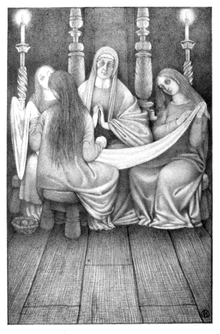Lord Thomas and Fair Annet
| "Lord Thomas and Fair Annet" | |
|---|---|
 Vernon Hill's illustration of Annet being dressed for the wedding by her handmaids. From Richard Chope's 1912 collection Ballads Weird and Wonderful.[1] | |
| Song | |
| Form | Folk song |
| Writer(s) | Traditional |
| Language | English |
Lord Thomas and Fair Annet (Child 73, Roud 4) is an English folk ballad.[2]
Synopsis
Lord Thomas (or Sweet Willie) is in love with Fair Annet, or Annie, or Elinor, but she has little property. He asks for advice. His father, mother, and brother (or some of them) advise that he should marry the nut-brown maid with a rich dowry. His mother promises to curse him if he marries Annet and bless him if he marries the nut-brown maid. His sister warns her that her dowry may be lost and then he will be stuck with nothing but a hideous bride. Nevertheless, he takes his mother's advice.
Fair Annet dresses as splendidly as she can and goes to the wedding. The nut-brown maid is so jealous that she stabs Annet to death. Lord Thomas stabs both the nut-brown maid and himself to death. A rose grew from Fair Annet's grave, a brier from Lord Thomas's, and they grew together.
Variations & Related Ballads
Regional and printed variations of the ballad are known by many titles, including "Fair Eleanor", "Lord Thomas and Fair Ellender", "Fair Ellen and the Brown Girl", "Lord Thomas's Wedding", "The Brown Bride", and others. Related English ballads which share stanza composition as well as narratives of heartbreak-induced death include Fair Margaret and Sweet William and Lord Lovel.[3][4]
Several Norse variants of this ballad exist, although the man does not reject the woman on advice of his friends in them.[5]
Commentary
The grave plants that grow together are a motif to express true love, also found in many variants of Barbara Allen and of Tristan and Iseult, and in the legend of Baucis and Philemon.
This ballad has no connection with "The Nut-Brown Maid", in which a nut-brown maid is the heroine.
See also
References
- ↑ Chope, Richard (1912). Ballads Weird and Wonderful. New York: John Lane Company. p. 60.
- ↑ Francis James Child, English and Scottish Popular Ballads, "Lord Thomas and Fair Annet"
- ↑ Francis James Child, The English and Scottish Popular Ballads, v 2, p 204, Dover Publications, New York 1965
- ↑ Coffin, Tristam P. (1950). The British Traditional Ballad in North America. Philadelphia, PA: The American Folklore Society. pp. 74–6.
- ↑ Francis James Child, The English and Scottish Popular Ballads, v 2, p 180, Dover Publications, New York 1965
External links
| Wikisource has original text related to this article: |
- Lord Thomas and Fair Ellinor with some history